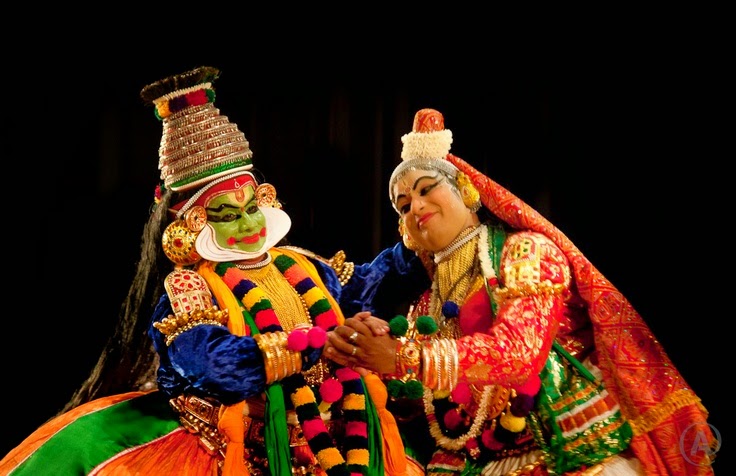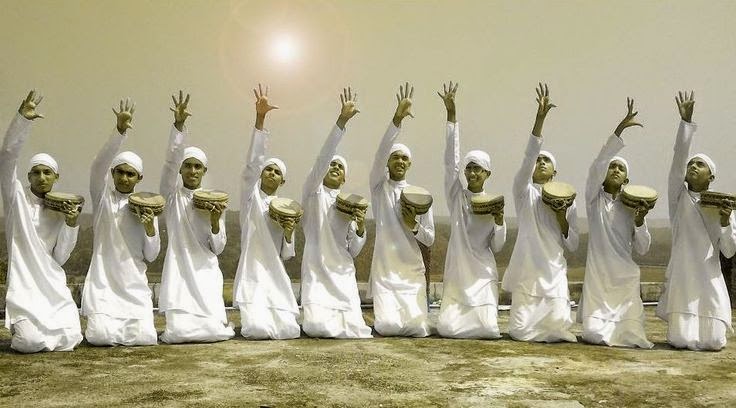- Kathakali
Kerala is known worldwide for Kathakali, which is generally performed by male
dancers. Usually staged on temple grounds, Kathakali is a classical dance form that utilizes detailed and stylized makeup and colorful costumes. The typical Kathakali costume includes a headgear, billowing skirt and plentiful ornaments.
During a typical performance, the artists play the role of mythological characters from Hindu epics such as Ramayana and Mahabharata. The entire story or a scene from a mythological story is depicted by the artists, by making use of graceful movements of hands, eyes and legs. Props are used wherever necessary. Chenda (traditional drum) player is accompanied by one or two singers, who narrate the story in the form of song. This completes a typical Kathakali performance.
- Mohiniyattam
Mohiniyattam is a sensual classical dance that involves graceful movements. Mohiniyattam is performed only by women. This dance includes elements belonging to other classical dances like Bharatanatyam and Kathakali. The dance movements are gentle and graceful, especially the eye movements which are mesmerizing.
Mohiniyattam is a dance form said to have originated in Kerala. It is closely related to Bharathanatyam of Tamil Nadu, which was originally called ‘Dasiyattam’. Mohiniyattam involves delicate footsteps and subtle expressions. The movements are graceful and the costumes are sober and attractive. Mohiniattam follows the Hastha Lakshanadeepika, a textbook for Mudras. The vocal music for Mohiniattam is classical Carnatic.
- Thirvathirakali
Thirvathirakali popular group dance is performed during Onam festival in Kerala. It is performed by women who move in circle and dance rhythmically to the tune of Thiruvathira songs.
In ancient times, women use to perform this dance in their homes during festivals and functions, giving it the Malayalam name aka Kaikottikali: aka-inside + kaikottikali-play claping hands. Lore has it that Thiruvathira Kali is in memory of Lord Siva taking Parvathi as his wife. A group of women dressed in typical Kerala style with mundu and neriyathu and the hair bun adorned with jasmine garlands perform this dance during festival seasons.. Kaikottikkali spreads the message of joy and also illustrates the emotions of a married woman towards her beloved and of the unmarried woman longing for one.
- Kolkalli
Kolkalli is highly rhythmic dance form. It is mainly performed by agrarian classes. It involves the use of wooden sticks as props. This dance is usually performed by a group of 24 dancers, who move in a circle beating the long sticks.
- Oppana Dance
Oppana is a dance form specific to the Muslim community of Kerala. Oppana is usually a bridal group dance performed the day before the wedding day. It is a dance form essential to the wedding entertainment and festivities of the Muslims especially in the Malabar region of Kerala. Oppana is generally presented by young female relatives of the bride, who sing and dance around the bride clapping their hands.
- Ottamthullal
Later it was staged as group dance involving many actors playing their character in the story. This art form is very popular among common man due to its satirical touch. During the performance, the dancer musically narrates a story, which may be based on mythological stories.
- Koodiyattam
Koodiyattam is a part of Sanskrit theatre art. The popular dance form of Kerala is the only remaining proof of the ancient Sanskrit Theatre. Traditionally, it was being played in temples for centuries. The important musical instruments used in Koodiyattam are Mizhavu, Kuzhitalam, Kurumkuzhal and Sankhu.
- Duffmuttu or Aravanmuttu
Duffmuttu (also known as Aravanmuttu or Arbanamuttu) is a dance form particular to the Muslim community of Kerala. The origin of Duffmutt can be traced back to the Arabs. It is still accompanied by Arabic music. The name Duffmuttu is attributed to the use of an instrument called duff or tap. Daff is a round percussion instrument with one side covered with hide and is used to produce rhythm.
- Chakyar Koothu
Chakyar koothu is a blend of social satire, mime and comedy. The Koothu basically depends on the main Hindu epics Ramayanam and Mahabaratham, which the Chakyars first chants the verses of in Sanskrit and then narrates the story in Malayalam. The Chakyar is a comedian par excellence, occasionally even mimicking the characters in a tongue-in-cheek manner and drawing social parallels between Puranic (Ramayanam and Mahabaratham) tales and modern life.
- Theyyam
Theyyam is a popular dance form performed in Malabar region of Kerala. For thousands of years, Theyyam and its rituals are in practice in this region. It is a Dravidian art form and is quite popular due to its accessibility to lower castes.
is a folk art performed in North Malabar region of Kerala State in south India. The dance performers move in a circle, striking small sticks and keeping rhythm with special steps. The circle expands and contracts as the dance progress. The accompanying music gradually rises in pitch and the dance reaches its climax.Many of the traditional performing art forms of Kerala like Kathakali, Velakali, Poorakkali and Thacholikali; Kolkali, also have drawn elements from Kalarippayatt during their stages of evolution. Kathakali has borrowed much from Kalarippayattu in its basic body preparative training of the actor not only in terms of technique in practice but also from the body massage for the trainee. Many of the body postures, choreography and foot work of the Kolkali characters are taken directly from Kalarippayattu.









No comments:
Post a Comment